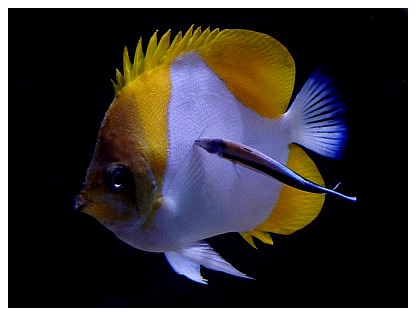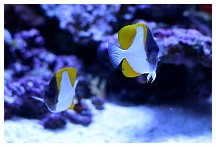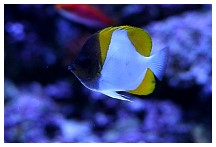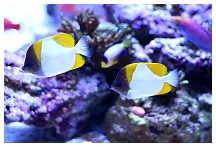Current Issue  Fish Profile
Fish Profile
 Fish Profile
Fish Profile
Fish Profile
Pyramid butterflyfish, Hemitaurichthys polylepis |
 |
Photo courtesy of Greg Rothschild.
 |
 |
 |
Photos courtesy of Brian Vu.
| Common Name: | Pyramid butterflyfish or Shy butterflyfish |
| Scientific Name: | Hemitaurichthys polylepis |
| Size: | Up to 18 cm |
| Distinguishing Features: | Hemitaurichthys polylepis has a square body that is white in coloration. Their head is triangle shaped, and black or brown in color. The dorsal and anal fins are yellow. There is a large white pyramid-shaped area on the side of their body. The caudal fin is white. |
| Distribution: | Pacific Ocean: Christmas Island in the eastern Indian Ocean to Indonesia and the Hawaiian, Line and Pitcairn islands, north to southern Japan, south to Rowley Shoals and New Caledonia. |
| Natural Habitat: | Hemitaurichthys polylepis occur in large schools that may extend several meters above the edges of steep current-swept outer reef slopes. |
| Feeding Requirements: | In the wild these fish feed primarily on plankton. In captivity they will usually accept Mysis, brine shrimp and mixed-blend frozen foods. They are quite accustomed to the idea that food should be floating in the water, as they find much of their food the same way in the wild. Feed a balanced diet by offering flake, pellets, frozen meaty foods and herbivorous foods. |
| Difficulty Rating: (1 = easy - 5 = hard) |
This fish can be difficult to keep and does best in an otherwise healthy system. Pyramid butterflyfish do best in a larger tank with less aggressive feeders. Adding them before more aggressive feeders and letting them establish themselves will give then a better chance. My experience leads me to a rating of "4." |
| Aggressiveness Rating: (1 = shy - 5 = nasty) |
I rate this fish a “2.” Although they seldom hide once settled in, they tend to shy away from larger fish during feeding. |
| Captive Requirements: | While these fish are quite hardy once acclimated, they still appreciate excellent water quality. I recommend adding them into quarantine before placing them in the display, allowing them to adjust to feeding. A tank of at least 6’ and a lot of swimming space is recommended. I have also found that they do better in groups. |
| Reef Tank Compatibility: | This fish is low risk to a reef tank inhabitants and generally considered reef safe. They feed on plankton in the wild so nipping at corals should not be a problem, although some aquarists have reported that they have experienced coral nipping. I have yet to observe any nipping in my experience while keeping them in a reef setting. |
| Personal Experience: | I have owned a few schools of this spectacular fish over my time in the hobby. While I have tried keeping them as singles in the past, I have found that they truly do best in small groups. Once settled in these fish will constantly swim and move as a true group. Being plankton feeders, I have never experienced any problem keeping these butterflyfish with corals. |
| Further Reading: | Fishbase.org - Hemitaurichthys polylepis |
Note: All of the above information has been compiled from various sources and should be used as a guideline, not a hardfast rule. Use caution when selecting animals for your own tank and research as much as possible before purchasing any animals. Remember that certain corals and fish are very hard to keep if their special requirements are not met. The information contained here is to help you make an informed decision. The author assumes no responsibility for any consequences that may arise from the use of this information.


